Gunwritersin osittainenkin
luvaton kopioiminen, tallentaminen, tulostaminen, väärentäminen tai levittäminen on
kielletty. Mikäli tällaisia tekijänoikeusrikkomustapauksia ilmenee, kirjoittajat
pidättävät itselleen oikeuden laskuttaa tekoon syyllistyneiltä
tekijänoikeuskorvauksia 150 000 mk saakka. - GOW:n
toimitus.
Tekniikkaa ja historiaa, osa 10.
15.10.2001:
TUTTUJA JA TUNTEMATTOMIA TÄYTEISAMMUKSIA
WELL-KNOWN AND LESS-KNOWN SHOTGUN PROJECTILES
Teemana edelleenkin haulikon täyteisammukset, joista piisaa pakinaa, kun
käytettävissä on vuodesta 1984 saakka "maalimalla harhaillutta", nyttemmin
kotiutunutta kuvamateriaaliakin. Tiivistellyt kuvatekstit ovat kaksikielisiä, eli
jokaisen "kaptiivin" jälkeen seuraavat samat lorut lontooksikin. HUOM:
Käännökset eivät ole täysin sanatarkkoja.
Theme is still Shotgun Slugs and Other Projectiles of the scatter
guns. Drawings are returns from editorial office of a Finnish commercial periodical
hunting magazine, drawn in 1984, presumed to be lost forever. Captives are written in
Finnish and English. PLEASE NOTE: Translations have different wording.
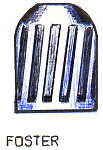 FOSTER SLUG
FOSTER SLUG
USA 1936. Ainakin kotimaassaan yhä ostetuin ja parhaiten tunnettu onttoperäinen rihlattu
lyijyinen täyteisluoti. Ladataan yleisimmin myös tehdaspatruunoihin.
Still a most popular type of rifled bore-sized lead slugs. Design of
KARL FOSTER, who made the slanted "air rifling" grooves on his first
hollow-based slugs by filing. He sold the projectiles one-by-one to his hungry neighbours
during the Great Depression in 1930s for deer poaching. Today are cold-swaged Foster Slugs
available also in factory-loaded cartridges of major shotgun shell manufactures especially
in USA. (PTK; 1984).
 UNITY ELGKULAN
UNITY ELGKULAN
Ruotsi, n. 1900. "Uppsalan Hirvikuula" oli aikalaisensa Original
Brenneke-täyteisen vähemmän tunnettu kilpailija. Todennäköinen suunnittelija oli
Uppsalan Yhtyneen Välitulppa-tehtaan tirehtööri, luutnantti ALMQUIST. Luodin
katkokartiomainen kärki oli "ilmarihlattu" pyällys-kehrällä. Huomaa
vasenkätinen kiertosuunta! Luoti oli onteloperäinen. Sen pohjan keskiöstä ulkoneva
lyijyputki kulki huopa-välitulpan keskelle stanssatun kanavan läpi, toimien sen
kiinnitysniittinä.
Luoti voitiin ampua vaaratta myös ahtaaksiporatuimmista HUSQVARNA-
ja SJÖGREN-haulikoista, mutta paras käynti saatiin aseella, jonka piipunputken
seinämät oli "pooritettu" eli suora-rihlattu ("rakräfflad").
Asetehdas HUSQVARNA VAPENFABRIK omaksui pooritus-menetelmän v. 1885 ja valmisti
suorarihlattuja piippuja tai piippupareja erikoistilauksesta 1950-luvulle asti.
16-kaliiperisen luodin paino vastasi 17 mm:n läpimittaisen pehmolyijyisen palloluodin
painoa. Luoti saattoi olla jo kylmäpuristettu, eikä valettu. Se puristui vaikeuksitta
ainakin 2 mm:n verran kaliiperikokoaan pienempään läpimittaan, joten ammunta
tiukastikin supistetuilla aseilla oli mahdollista.
"UNITY" Moose Bullet: Sweden, ca. 1900. A short-lived
competitor of contemporary German BRENNEKE "Old Model" rifled slug. Designed
presumably by Swedish Artillery Lieutenant ALMQVIST, a contemporary manager of SWEDISH GUN
WAD MANUFACTURE "UNITY" in Uppsala, Sweden. (Name of firm was TRULY in English,
since the remarkable stockholders of this company were Britons: W.W. GREENER and some
cartridge manufacturers, using famous hollow based "Swedish Wads" for early
smokeless "Dense Nitro Powder" shotshells). Lead bullet was hollow-based,
truncated-cone shaped and "rifled" with a knurling wheel. Note unusual
left-handed "air rifling"
Integral tubular lead spindle projected from bullet's base. It went through the central
passage of a felt tail-wad and was expanded to become a "rivet" for fixing a
tail-wad. Whether the lead slugs were cast or swagad? It remains a mystery. At least they
COULD be swagad from a cold lead cylinder and the fine "air rifling" was done by
knurling presumably during the riveting process. "Elgkulan afv Uppsala" - the
moose bullet - was very easy to compress 2 millimeters smaller from it's original
diameter. Therefore it was safe to shoot (with blackpowder charge) through extra-full
chokes of contemporary HUSQVARNA Rolling Block or later
SJOEGREN self-loading shotguns, having a tapered bore AND usually a GREENER choke in the
muzzle.
The very best accuracy was - however - obtainable from Husqvarna's custom-made cylinder
barrels with "rakreffling"; straight rifling with narrow "micro
grooves" without any twist. Husqvarna Vapenfabrik inroduced them in 1885, and the
spare barrels with "rakreffling" were available for Husqvarna shotguns still in
1950s. Why not spiral grooves? Because they generated excessive spread of shot charges,
while barrel(s) with straight rifling was (were) able to shoot shot patterns similar to
Improved Modified or Full Choke, if the cartridges were (hand)loaded "LEGE
ARTIS" (according to the Rules of Art). Majority of "Uppsala's Moose
Bullets" were dimensioned for 16 gauge guns. Weight of the lead point & spindle
equals weight of a spherical pure lead bullet with 17.0 mm diameter.
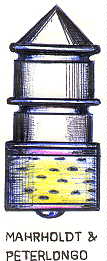 MAHRHOLDT &
PETERLONGO
MAHRHOLDT &
PETERLONGO
Saksalainen "tarkkuustäyteinen" 1930- luvulta. Raskas ja hitaasti
(aliääni-nopeudella) lentävä ammus. Ampuisi ilmeisesti yhä vieläkin huippu-kasoja
haulikko-kasakisoissa sileäreikäisten ja rihlattujen aseiden sarjoissa, mutta aseen
peränpitäjän pitäisi olla masokisti ja aseen optisen tähtäimen korosäädön vara
voisi loppua kesken jo 100 metriin ammuttaessa. Korkkinen pyrstötulppa oli
ruuvikiinnitteinen kuten Original Brenneke-luodeissa, mutta huopatulppaa kevyempi.
A German "competition-grade slug", designed in 1930s by a
famous gunwriter Mahrholdt. Heavy slow-flying (subsonic) lead projectile with a
screw-fixed cork tail wad. Able to be successful even today in shotgun bench-rest
competitions, with smooth-bore (including choked) and rifled bore classes up to 100
yards/meters, but a crooked trajectory may cause some problems - especially for users of
some optical sights with limited elevation.
The shooter must be some kind of masochist: Recoil is heavy if the gun is light. For
hunting the ORIGINAL BRENNEKE MODELL 1930 was more popular (and it is still preferred, in
1984 and 2001). M & P slug disappeared from production presumably before the Second
World War.
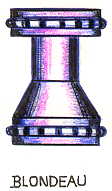 BALLE BLONDEAU
BALLE BLONDEAU
BALLE BLONDEAU kehiteltiin 2. maailmansodan aikaan Ranskan vastarintaliikkeen
käyttötarkoituksiin, mutta unohdettiin sodan päätyttyä. Toistamiseen se esiteltiin
1960-luvun jälkipuolella "risuvarmana" metsästysluotina, mutta unohdettiin
jälleen muutamien vuosien pituisen tuotantorynnäkön jälkeen. 1980-luvun vaihteen
jälkeen se tuli uudelleen muotiin; tällä kertaa ilmeisesti jäädäkseen. Taannoin
tässä sarjassamme esitelty PMDK-luoti on Blondeau'n
"pupiinin" (= lankarullan) esikuva, eroavuutena lähinnä alikaliiperisuus ja
suositeltu lataustekniikka: PMDK ammutaan ohjeiden mukaan painava pää edellä, kun taas
"pupiini-ammus" antaa paremman tarkkuuden haulikkohollille lentäessään
yliäänisellä nopeudella peräpainoisena. Pyrkimyksenä on siis muotovakautuvuus, eikä
massavakautus. Oikeellinen lataustapa lienee keksitty vahingossa.
Teräksestä sorvattu (nykyään yleensä kuparilla silattu) Balle Blondeau on sekin
alikaliiperinen ja ammuttavissa jopa täyssupistetusta piipusta. Luodin
"johtorenkaat" ovat lyijyä. Jos ne on pykälöity (kuten kuvassa), voidaan
luoteja ampua ahtaankin suusupistuksen läpi. Jos lyijyrenkaat ovat sileät, kuten
viimeaikaisissa luodeissa, on viisainta tyytyä vähempiin supistusasteisiin (Improved
Cylinderiin) tai sylinteriporaukseen, ellei piippu ole nykymuodin mukaisesti rihlattu koko
pituudeltaan tai Paradox-rihlattu (vain suustaan). Luotia ei ole tarkoitettu ammuttavaksi
normaalia haulikkomatkaa kauemmaksi. Kun sen lentonopeus vähenee aliääniseksi, se
menettää vakautumiskykynsä, tarkkuutensa, ja pian myös osumatehonsa ilmanvastuksen
vaikutuksesta, ellei vakautuvuutta ole parannettu kiertoliikkeellä.
BALLE BLONDEAU (France) was designed by Pierre Blondeau during
Second World War for paramilitary purposes. Designer Blondeau was an active
member of French Maquissard resistance movement. It was found that a burst of STEN
submachine gun was unable to damage even the unarmored motor vehicles, but a shot or two
from a shotgun could be effective, if the projectile had some kind of sheet metal
perforation. Use of spherical hardened steel bearing balls was familiar to Frenchmen from
MGM shells designed for wild boar hunting, but for destruction of much bigger
"game" was needed a cylindrical wadcutter-like shotgun bullet. Many shotguns
were confiscated by Germans, but quantity of them were hidden to the "yemmah"
(a cache in Finnish) before the occupation of France.
After the WW II, design of P. Blondeau was almost forgotten elsewhere but in France. In
the last half of 1960s it was suddenly once again known world-wide as a good and accurate
big-game bullet, when introduced by the GUN DIGEST yearbook as "a revolutionary new
discovery", but again forgotten until early 1980s when copies of Balle Blondeau were
produced also outside France: "Imitation is the highest degree of flattery!".
For example, the sub-caliber (saboted) PMDK bullet, described earlier on this GOW's series
"Technics and History" (also bi-lingually) is nothing but a cheaper variation of
Blondeau's Bullet.
Balle Blondeau or "French Bobbin Bullet" is also a sub-caliber projectile with
diameter of it's flat point and base considerably less than the diameter of shotgun bore
and muzzle of even the gun with Full Choke. There are narrow lead belts fastened into
grooves around point and base of the "bobbin". They make the bullet to become
bore-sized and well-fitting into the shotshell case. Blondeau projectiles had notched lead
rings in 1960s. It was possible to shoot them even from Full-Choked shotgun bore
(constriction ca. one millimeter in 12 gauge gun).
Some later copies have smooth lead rings of about nominal bore size in diameter. They are
O.K. for the bores with Modified choke, Improved Cylinder choked or True Cylinder bores,
and the special Slug Bore of guns like ITHACA "Deerslayer", along with the guns
with a Paradox rifling, or rifled shotgun (spare) barrels.
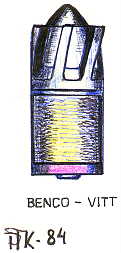 BENCO-VITT
BENCO-VITT
USA. Eräs lukuisista BRENNEKE-täyteisen malli 1930 variaatioista. Esikuvaansa tarkempi
joissain ase-yksilöissä jopa 100 yardiin/metriin asti. Myytiin kovaan hintaan
kotilataajille, mutta ei liene ladattu mihinkään "tehtaanpatruunaan".
Erikoisuutena ylisyvät "ilmarihlat" ja leveät rihlanpalkit niiden välissä.
BENCO-VITT is or was an American rifled slug, designed to be "a
hundred yards target shooting projectile" rather than a projectile for hunting to the
reasonable shotgun ranges (no more than ca. 40 meters). It was nothing but a variation of
Original Brenneke Mod. 1930 projectile, with more deep grooves and more wide slanted ribs.
Never adopted for factory-loaded cartridges, as far as I know. Sold for handloaders at
high price, presumably for the long-range target shooting only.
 Von
WITZLEBEN-luoti/ shotgun dart
Von
WITZLEBEN-luoti/ shotgun dart
"Haulikkonuoli" 1900-luvun vaihteesta. Saksalainen tai Baltian saksalainen
aatelismies von WITZLEBEN, jonka otaksutaan asuneen jossain vaiheessa Suomessakin, aloitti
taittopiippuisiin haulikoihin ladattavien nuoliammustan kehittelyn jo 1890-luvulla,
patentoidenkin joitain konstruktioitaan, joiden kaupallinen menestys jäi kuitenkin
vähäiseksi. Kuvan esittämä ammus oli tuotannossa Saksassa ainakin vielä vuonna 1903.
Se työnnettiin irrallaan aseen piipunputkeen, ja perään erityinen ajopanos, kuten
haupitsia ladattaessa. Ammuksen lempinimi oli "Elster-Geschoss" (=
harakkaluoti), koska se lensi hitaasti, uritettua balsapuupyrstöään silminnäkyvästi
keikuttaen, mutta erinomaisella tarkkuudella ainakin 40 metrin etäisyydelle. Ammus
kahlasi vaikeuksitta saksanhirven läpi, vaikka lähtönopeus oli vähäinen.
"Shotgun dart", designed by a German or Baltic German
nobleman von WITZLEBEN in the turn of 20th Century. (There is at least a legend that he
resided in Finland in late 1800s). The first foot-long arrow projectiles were designed in
mid-1890s. Some of them were patented, but commercial success of them was poor. Hunters
made presumably the arrows of balsa wood rods with wax impregnated cotton cord
concentrators for their own use. A rather complicated expanding lead point was cast to the
tips of arrows with a mould, patented by von Witzleben.
Arrow was pushed into the bore of shotgun just like a howitzer shell and a driving charge
was pushed separately behind it in the cartridge case, loaded with a small blackpowder
load and wadding only. (Japanese makers of "ninya" and "samurai"
movies use also shotguns - not long bows or even the crossbows - for throwing the arrows
with very small powder charges). Von Witzleben's shotgun darts became shorter. This drawn
one was for sale still in 1903 in Germany. Longitudinally grooved tail was still of
balsawood. A loose projectile was fed into the chamber of "break-loading"
shotgun and a driving charge was chambered behind a dart. Muzzle velocity of projectile
was slow. It was known as an "Elster-Geschoss" (a "magpie
bullet") due to swinging of its tail in flight. Bullet was - however - accurate to
ca. 40 meters range and it perforated easily an elk, when hit sideways.
Viimeiset von Witzleben-luodit voitiin ladata aseeseen patruunaan
asetettuina. Puupyrstö meni kokonaan hylsyyn, mutta kovalyijyinen tai valurautainen
kärki ulkoni patruunasta. Ammusta voitiin käyttää vain taittoladattavan aseen
"riistalaukauksen" ammuntaan. Kaksipiippuisen aseen "paikkolaukaus"
piti ampua toisentyyppisellä patruunalla, koska von Witzlebenin haulikkonuolet eivät
sietäneet rekyyliä. Joissain luotimalleissa oli kärkipiikki kuin nykyisissä
ranskalaisissa T.H.V. -käsiaseluodeissa, ja valurautakärkinen ammus oli nimeltään
"Granaten-Geschoss", vaikka se ei tiettävästi sisältänyt
räjähdettä ja sytytintä. Liereää kärkeä ympäröivät kaksi "vanneketta"
muistuttivat tykinammuksen johtorenkaita. Niiden materiaalina oli ilmeisesti lyijy.
Pyrstömateriaali oli vahalla kyllästettyä kevyttä palsapuuta. Stuukattuihin
patruunoihin ladatut Brenneke-täyteisluodit syrjäyttivät pian
"haulikkonuolet" unohduksiin. Japanissa ammutaan kuitenkin nuolia (myös pitkiä
käsijousen sulitettuja nuolia) haulikolla, pienellä ajopanoksella, filmattaessa samurai-
ja ninja-elokuvia. Käsi- tai jalkajousenkaan osumatarkkuuteen ei täysin luoteta
"kelattaessa purkkiin" hurjimpia jousiammunta-kohtauksia elokuviin, joita
Suomessa ei nähtäne ikinä, teattereissa eikä televisiossakaan.
Modernized von Witzleben bullets were chambered into shotguns seated into shells. The
cartridge case held a wooden tail and thin over-powder wadding, but the point of a dart
(hard lead alloy or cast iron; considerably sub-caliber) extended even from the mouth of
non-crimped full length shotsell. These cartridges were shot from break-loader shotgun's
one barrel only - and definitely first. Another barrel was loaded with some other kind of
cartridge (usually with "Sauposten" canister, seated into the
roll-crimped shell). Von Witzleben's dart cartridges were unable to stand recoil of other
barrel. Usage in the repeater shotgun was impossible, of course. The earliest Brenneke
slug, seated into roll-crimped shell, was therefore an overwhelming competitor.
Some bullets of v. Witzleben's design were futuristic, having a point thorn similar to
that of French T.H.V. handgun projectile. Another projectile, with a wadcutter cast iron
point, was sold as a "Granaten-Geschoss" ("artillery shell
projectile") but, as far as I know, it contained no explosive charge and fuze. It
might have lead belts around it's point and base of the cast iron cylinder (like rotation
bands of an artillery shell) equipped with a fluted balsa wood tail.
RASKAS PARADOX-LUOTI/ HEAVY PARADOX SLUG (Englanti/ Britain 1885).
1800-luvun lopulla kehiteltiin Englannissa kaksikin ratkaisuiltaan itsenäistä rihlattua
haulikkoa, nimittäin WINCENT FOSBERY:n patentoima "Paradox" ja WILLIAM
WELLINGTON GREENER:in "Choke-Bore Rifle". Ensinmainitun piipunputki on sileä
kuten haulikossa, mutta suusupistukseen on höylätty 50 - 76 mm:n pituinen kiertyvä
rihlattu osuus; profiililtaan ns. "räikkärihlaus". Greenerin järjestelmä on
vähemmän tunnettu, mutta sen piippu oli rihlattu lähes koko pituudeltaan, mahdollisesti
LANCASTER:in soikiorihlauksella tai matalakuurnaisella METFORD- rihlauksella.
(Mainostekstin mukaan: "Kuurnitus on näkymätön, eikä likaannu, ollen yhtä helppo
pitää kiiltävänä ja puhtaana - koko pituudeltaan - kuten haulikon piippu").
Englannin asetarkastusmääräysten mukaan nimettiin ase "luodikoksi", koska sen
varsinainen piipunputki oli rihlattu. Paradox-rihlattu ase luokiteltiin haulikoksi, vaikka
Greenerin ase ampui haulipanoksia huomattavasti vähemmällä hajonnalla, jos sen tilaaja
halusi "kokoavamman" supistuksen aseyksilöönsä.
Rihlatun osuuden etupuolella oli piipunreikä avarrettu ns. "Tula-supistuksen"
tapaan (mikä menettely oli tosin tunnettu jo 1700-luvulla) ja avarretun osuuden edessä
oli supistusosuus, jonka "kokoavuus" säädettiin aseen tilaajan toivomuksen
mukaan sylinteriporauksen kaltaiseksi tai jopa tuottamaan puolisuppean aseen tapainen
supistusvaikutus. "Paradox"-haulikolla ammutun hauliparven hajonta oli melkoinen
roiskaus, koska nousulliset rihlat piipunsuussa saivat haulipanoksen pyörimään piipun
pituusakselin ympäri, mutta joissain metsästysmuodoissa oli keskipakovoiman tuottamasta
hajonnasta hyötyäkin, vaikka aseen kantama haulipanoksilla jäikin lyhyenlaiseksi.
Greener-järjestelmällä saatiin aikaan lähes normaalin haulikon kantama, koska
haulipanoksen kiertoliike pysähtyi sen ahtautuessa supistusosuuden läpi, laajennuttuaan
ensin avarretussa osuudessa. Supistetun osuuden sisäläpimitta oli hieman luodin
halkaisijaa suurempi, joten luoti kulki sen läpi seinämiä hipomatta.
Tiedossani ei ole, josko supistusosa oli kuurnitettu suorilla rihla-urilla jo Choke-Bore
Rifle:ssä. Thompson/Center Contender-metsästyspistoolin niissä malleissa, joilla
ammutaan luoti- ja haulipatruunoita - esimerkiksi .45 Long Colt ja .410 kal.
haulikonpatruunoita - pysäytetään haulipanoksen kiertoliike supistussuuhisen
sisäpuolisilla uurteilla, jotka toimivat myös suuhisen kiinnitysavaimen uurteina.
Vanhemmassa T/C C:n piippuyhdistelmässä kaliberi .45 LC/ .410 shotshell oli
paisuntakammio/ suujarru kiinnitettynä piipunsuun ulkopuolisiin kierteisiin, ja suorilla
rihloilla kuurnitettu supistusosa paisuntakammion suulla. Supistus-osuuden läpimitta oli
hieman .45 LC:n luodin läpimittaa avarampi, joten luoti- ja haulipatruunoita voitiin
ampua "sekaisin", häätymättä irrottamaan supistussuuhista luotipatruunoiden
ammuntaan ryhdyttäessä
Rihlapiippuiset haulikot tai rihlatut vaihtopiiput ovat tehneet "come-backia" jo
vuosien ajan etenkin USA:ssa. Samoin on saatavilla rihlattuja "Paradox-suuhisia"
jo olemassaoleviin piippuihin. Vakiomalliset täyteisluodit (mallit FOSTER tai BRENNEKE)
voivat tuottaa pettymyksiä rihlapiipun tai -suuhisen kautta ammuttuina (ellei niiden
rihlaus ole vasemmalle kiertyvä), mutta tuotannossa on jo viljalti haulikon
rihlapiippuihin kehiteltyjä erikoisammuksia ja jopa niiden valumuotteja. Ammukset ovat
usein alikaliiperisia "sabot slug:eja", jotka asetetaan patruunoihin hivakan eli
haulikupin ympäröiminä. Muovinen hivakka toimii ammuksen tilapäisenä vaippana
piippuvaiheen ajan. Piipusta lentoradalleen tulleen ammuksen ympäriltä kiskaisee hivakan
irralleen ilmanvastus, kuten haulipanoksenkin ympäriltä.
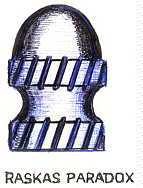 Kuvan esittämä pehmolyijyinen
Paradox-luoti on täyskaliiperinen ja täyspainoinen; umpikärkinen.
Pyälletyistä "johtorenkaista" päätellen se voitiin ampua myös
sileäreikäisestä täys-supistetusta haulikosta. Umpikärkinen luoti oli massavakautuva,
eli sen kiertoliike ei ollut täysin välttämätön, mutta rotaatio toki kaksinkertaisti
tarkan kantaman jopa 100 metriin. Sileäreikäisellä haulikolla voitiin ampua normaalille
haulikkohollille, noin 35 metriin, mikä usein riittikin. Paradox-luotien valikoima oli
kuitenkin huomattava, ja kevytkärkisemmät variaatiot vaativat rihloista saadun
kiertoliikkeen, lentääkseen kärki edellä. Luotimallistoon kuuluivat reikäpääluodit
(jotka voitiin täyttää räjähdeluodeiksi), syvälle kahlaavat teräs- tai
alumiinikärkiset luodit (norsujahtiin) ja jopa piiskatykin ammusta muistuttavat
suhteellisen pitkät suippokärkiset luodit, joiden ontto kärki oli alumiinipeltinen
"tuulikilpi" eli "ballistinen kärki".
Kuvan esittämä pehmolyijyinen
Paradox-luoti on täyskaliiperinen ja täyspainoinen; umpikärkinen.
Pyälletyistä "johtorenkaista" päätellen se voitiin ampua myös
sileäreikäisestä täys-supistetusta haulikosta. Umpikärkinen luoti oli massavakautuva,
eli sen kiertoliike ei ollut täysin välttämätön, mutta rotaatio toki kaksinkertaisti
tarkan kantaman jopa 100 metriin. Sileäreikäisellä haulikolla voitiin ampua normaalille
haulikkohollille, noin 35 metriin, mikä usein riittikin. Paradox-luotien valikoima oli
kuitenkin huomattava, ja kevytkärkisemmät variaatiot vaativat rihloista saadun
kiertoliikkeen, lentääkseen kärki edellä. Luotimallistoon kuuluivat reikäpääluodit
(jotka voitiin täyttää räjähdeluodeiksi), syvälle kahlaavat teräs- tai
alumiinikärkiset luodit (norsujahtiin) ja jopa piiskatykin ammusta muistuttavat
suhteellisen pitkät suippokärkiset luodit, joiden ontto kärki oli alumiinipeltinen
"tuulikilpi" eli "ballistinen kärki".
Paradox Shotgun was invention of Briton VINCENT FOSBERY in
mid-1880s. It had full-choked smooth bore(s) with a ratchet rifling in the muzzle(s),
length of rifling 2 to 3 inches. It's twist was steep enough to give rotation for
gyro-stabilizing of pointed bullets. Another design was a "Choke-Bore Rifle" by
WILLIAM WELLINGTON GREENER. It had a rifled bore from chamber to a "jug choke"
of muzzle (also known as "TULA-choke", although invented by a Frenchman MAROLLES
in 1700s, if not still earlier. Many makers of "long-range fowling pieces" kept
their inventions secret).
W.W. Greener told on his advertisement in 1910: "THE CHOKE-BORE RIFLE. A PERFRCT
SHOT-GUN AND A PERFECT RIFLE IN ONE. It performs equally well with conical and spherical
ball, solid and hollow bullets, light and heavy charges of powder, and shoots shots of any
size making regular patterns, either cylinder or choke, as ordered. The grooving is
invisible, cannot foul, and is as easily kept bright and clean - throughout its whole
length - as is the barrel of a shot-gun".
Whether the grooves of Choke-Bore Rifle were like LANCASTER Oval Bore rifling or shallow
rounded METFORD rifling, it remains a mystery, but the "invisible grooving" is
very difficult to produce into the bore of (say) 10 gauge gun. Greener's factory in
Birmingham produced those guns in every gauge between 10 and 28. Presumably they were all
custom made guns and therefore rarities. Although these guns were more successful when
used as the shotguns than the Paradox guns (which gave to the best just Improved Cylinder
patterns with bird shots), they were called as "rifles" because of the rules of
British Gun Proof Act, since the main length of their bores were rifled.
I don't know, whether the choked muzzle ahead of the barrel recess was rifled with
straight grooves to stop rotation of the shot charge. It is at least logical! The choke
diameter was, of course, somewhat more large than diameter of the spherical or conical
bullet. Some early barrels of THOMPSON/CENTER CONTENDER hunting pistol, chambered for .45
Long Colt cartridges and .410 shotshells, had an expansion chamber (like CUTTS
COMPENSATOR) ahead muzzle of the rifled barrel. On the mouth of chamber was a choke, wide
enough to allow free passage of .45 caliber bullet, but the shot charge of .410 shell
expanded in the chamber before driving through a choke, which was grooved with
"straight rifling".
The rotation of shot charge was stopped and it didn't cause scatter of the shot pellets,
but a really efficient choke effect. Modern T/C Contender pistols have also a choke device
with broad and deep longitudinal grooves, if the barrel is designed for shooting with
bulleted cartridges or shot-capsule cartridges (or .45 Long Colt ammo and .410-bore
shotshells), but I don't know, whether or not this choke device must be removed before
shooting with bulleted cartridges. (Those barrels of T/C C with a choke device are
extremely rare in Finland).
Rifled shotgun barrels and the "Paradox choke devices" are coming back
especially in USA (usually for repeater shotguns), and so are also projectiles of rifled
or Paradox rifled shotguns, but these bullets are usually "saboted slugs";
shootable through the bore "jacketed" with a plastic shot container. There are
available also the bullet moulds for these sub-caliber slugs. Projectiles may be of harder
than lead (alloy) metal, copper, brass, steel or even hardened steel for some special
purposes.
A Paradox bullet on picture above is of almost pure lead. "Rotating bands" of it
are notched. The bullet's point is solid. It was possible to shoot it from the smoothbored
shotguns, also from Full Choked guns to the usual shotgun range, ca. 35 meters or yards.
From Paradox rifled or Greener's Choke-Bore Rifle the accurate range was up to 100 yards
or meters. Assortment of the Paradox bullet was large. There were also "conical"
bullets with hollow point (could be "charged" with explosive filling or some wax
mixture for enhanced expansion, or equipped with a copper tube), the bullets with solid
steel or aluminium point with enhanced penetration for hunting of thick-skinned game
animals (including rhinoceros and even the elephants) and bullets like an artillery shells
with the hollow cone-shaped sharp aluminium "ballistic point". These bullets
with light points were, of course, stable in flight only when shot through the rifled bore
or muzzle.
PARADOX-KUULA/ PARADOX BALL (Englanti/Britain 1885)
Haulikolla ammuttava palloluoti. Sovelias toki myös Paradox-haulikoihin tai Greener:in
"supistusporattuihin kivääreihin". Greenerin mainoksen mukaan "juuri
palloluodin pysähdytys-woimuus (stopping power) on kaikkein suurriistan metsästäjäin
hywin tuntema. Ja waikka ase tätä järjestelmää painaaki wain seitsemän naulaa (3.2
kg), taidetaan pieniä hajonta-kuwioita ampua aina 100 yardiin asti kruudin ladingilla
6.67 grammaa, ynnä pallo-luodin kera, ilman ylönpalttista taka-potkaisua 28 tuuman
pituisista piipuista 12 kaliiperin aseesta". Vuonna 1910 oli käytettävissä jo
puoli- tai perki-savuttomiakin ruuteja. Niiden lataus säädettiin antamaan
täyskaliiperiselle 18.52 mm:n läpimittaiselle pehmolyijykuulalla samansuuruinen
lähtönopeus, jonka antoi 3.75 dramin eli 103 grainin lataus mustaruutia CURTIS &
HARVEY, karkeusaste FFFG. Latausten "dram-ekvivalenssi" oli siis 3 3/4.
Tiheäjyväisimpien savuttomien ruutien latauspaino oli ehkä vain 1.2 dram-mittaa.
Niillä ladattiin patruunoita pääsääntöisesti vain tehtaissa.
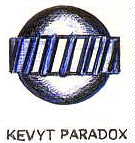 Kuvan esittämä luoti on
Greenerin mainitsemaa 1/12 naulan painoista lyijykuulaa kevyempi. Se voitiin ampua myös
tavanomaisesta, jopa täyssupistetusta haulikosta, koska pehmolyijyisen kuulan
"ekvaattorin" ympäri kulkeva vyö oli lovitettu. Täyssuppealla aseella ammutun
luodin keskitysvyön lovet painuivat umpeen, mutta sylinteriporatulla haulikolla ammutun
kuulan vyön viistot lovet toimivat "ilmarihloina", jotka antoivat ammukselle
verkkaisen kiertoliikkeen. Ja hidaskin kierto lentoradan ympäri ehkäisee suunnaltaan
epämääräiset, osumatarkkuutta huonontavat kiertoliikkeet. Palloluodin tapauksessa ei
kiertonopeudella ole väliä kuulan vakautuvuuden kannalta, kunhan pyörimissuunta vain on
sama joka laukauksella.
Kuvan esittämä luoti on
Greenerin mainitsemaa 1/12 naulan painoista lyijykuulaa kevyempi. Se voitiin ampua myös
tavanomaisesta, jopa täyssupistetusta haulikosta, koska pehmolyijyisen kuulan
"ekvaattorin" ympäri kulkeva vyö oli lovitettu. Täyssuppealla aseella ammutun
luodin keskitysvyön lovet painuivat umpeen, mutta sylinteriporatulla haulikolla ammutun
kuulan vyön viistot lovet toimivat "ilmarihloina", jotka antoivat ammukselle
verkkaisen kiertoliikkeen. Ja hidaskin kierto lentoradan ympäri ehkäisee suunnaltaan
epämääräiset, osumatarkkuutta huonontavat kiertoliikkeet. Palloluodin tapauksessa ei
kiertonopeudella ole väliä kuulan vakautuvuuden kannalta, kunhan pyörimissuunta vain on
sama joka laukauksella.
Spherical soft lead ball for shotguns. Fit for use in Paradox-rifled
shotguns and Greener's Choke-Bore Rifles too. According to advertisement of W.W. Greener
(in 1910): "the 'stopping' power of the Spherical Ball is well known to all hunters
of large game. With a guns of this system (Choke-Bore), weighing 7 lb, GOOD DIAGRAMS can
be made up to 100 yards, with charges of powder up to 3.75 drams (= 103 grains) and a
spherical ball WITHOUT EXCESSIVE RECOIL. 12-bore gun with 28-in. barrels can be made as
light as 7 lb." Powder charge was of black powder, about FFF-Grade, or equivalent
load of semi-smokeless propellant or smokeless "dense" Nitro powder. Charge
weight was considerably lighter than weight of blackpowder charge, but it was adjusted to
give as high bullet velocity as 103 grains of 3 3/4 drams of CURTIS & HARVEY's FFFG
black powder. Smokeless cartridges were usually factory-loaded in early 1900s.
Bullet in our picture is less heavy than 1/12 Imperial Pound ball for 12 gauge shotgun. It
has a bore-sized concentration belt around it's "equator", with the notches.
They were blocked, when the ball was shot through a Full Choked bore, but remained open in
the True Cylinder bore. The slanted notches acted then as "air rifling", giving
very slow rotation around the trajectory of a ball. This very slow rotation prevents any
random rotations of a spherical projectile, but direction of the stabilizing rotation
should be uniform, of course.
1010 MMI; PT
Muita Tekniikkaa ja historiaa -osia:
Other Technology & History Articles:
Tuttuja ja tuntemattomia täyteisammuksia >>
Täyteis-aiheisia arkistolöydöksiä >>
Uus-aikaisten käsiaseiden ruudit >>
Palaako - vaiko räjähtää? >>
Mauser C96 käsikirja osa 1, osa 2 ja osa 3
>>
Talvisotaisia myyttejä ja muistelmia >>
Norsupyssyn kunnostus ja käyttöönotto >>
Mustaruuti tiivistyi "valssin tahdissa" >>
Husovaarnan huoripojat >>
Norsupyssyn ampumatarvikkeet >>
Schouboen pyssyt ja puukeernakuulat >>
Gunwritersin osittainenkin luvaton kopioiminen, tallentaminen, tulostaminen, väärentäminen tai levittäminen on kielletty. Mikäli tällaisia tekijänoikeusrikkomustapauksia ilmenee, kirjoittajat pidättävät itselleen oikeuden laskuttaa tekoon syyllistyneiltä tekijänoikeuskorvauksia 150 000 mk saakka. - GOW:n toimitus.
Gunwriters on the Web P.T. Kekkonen